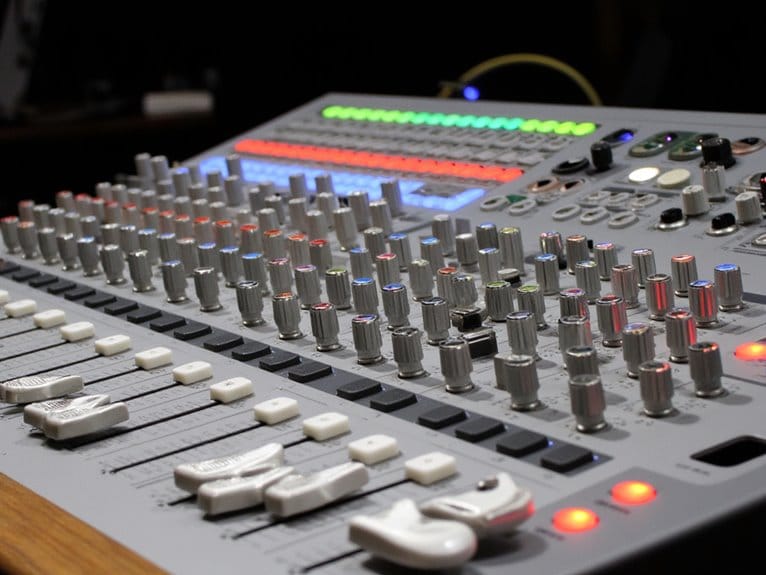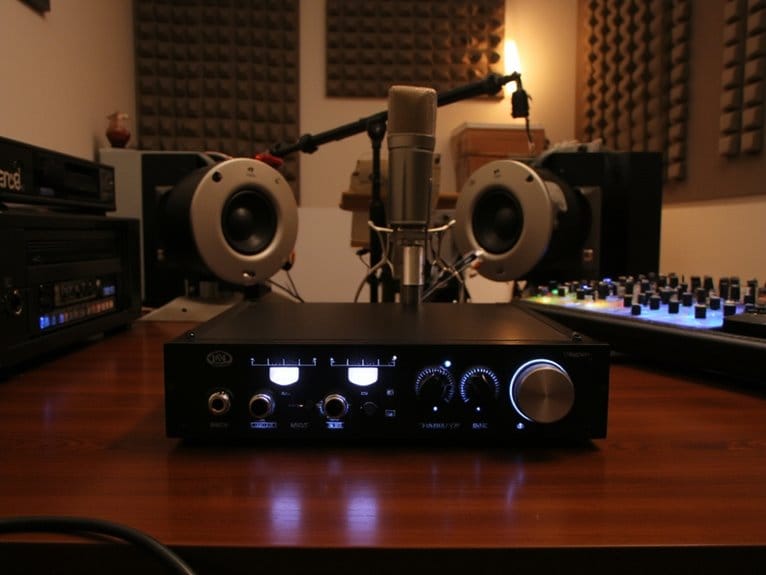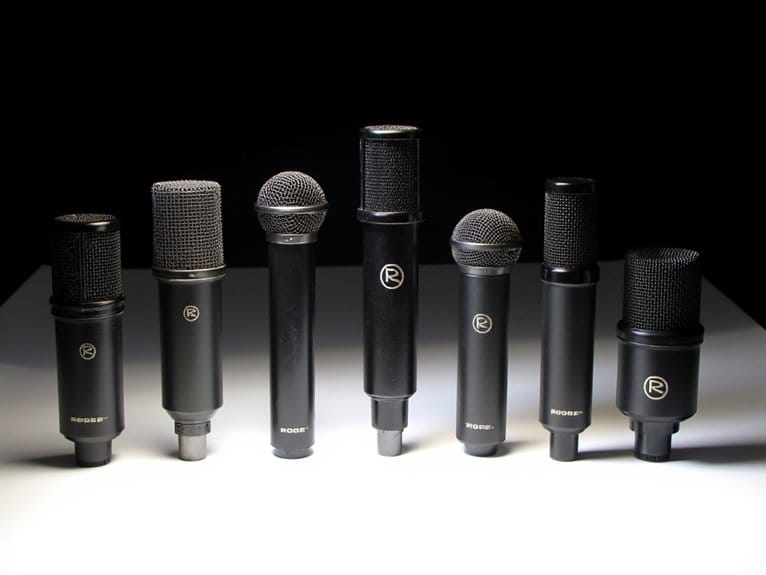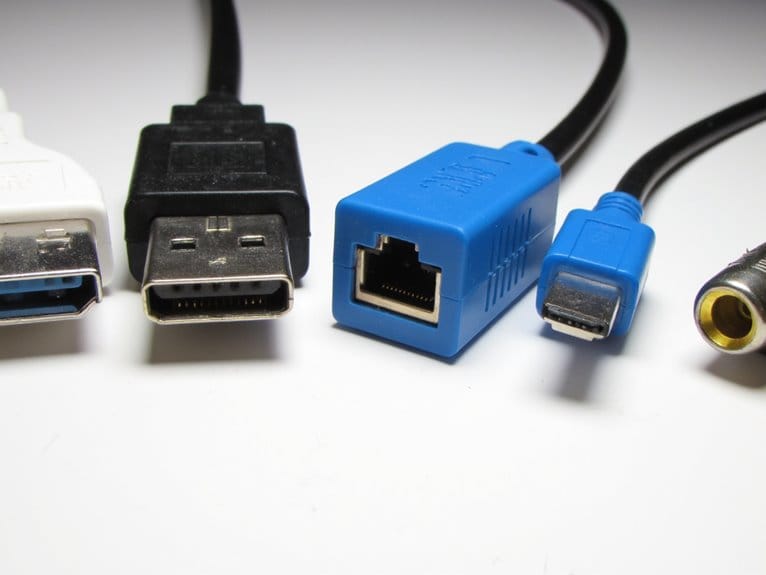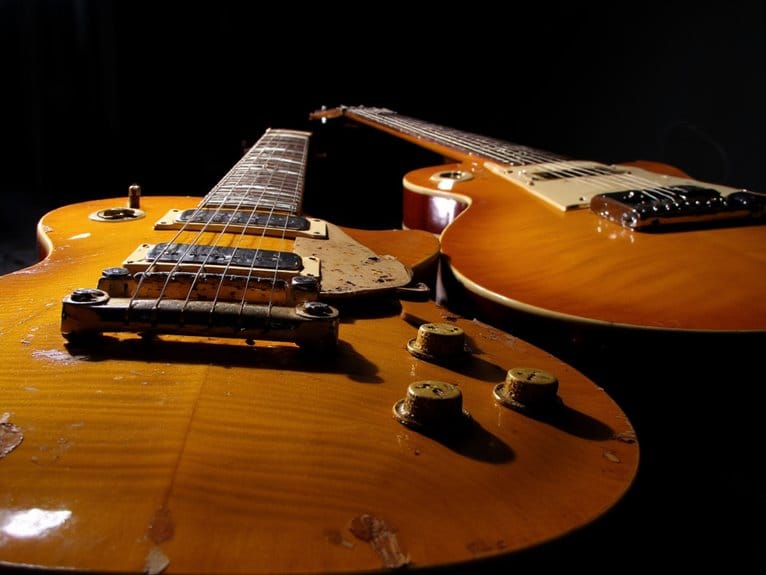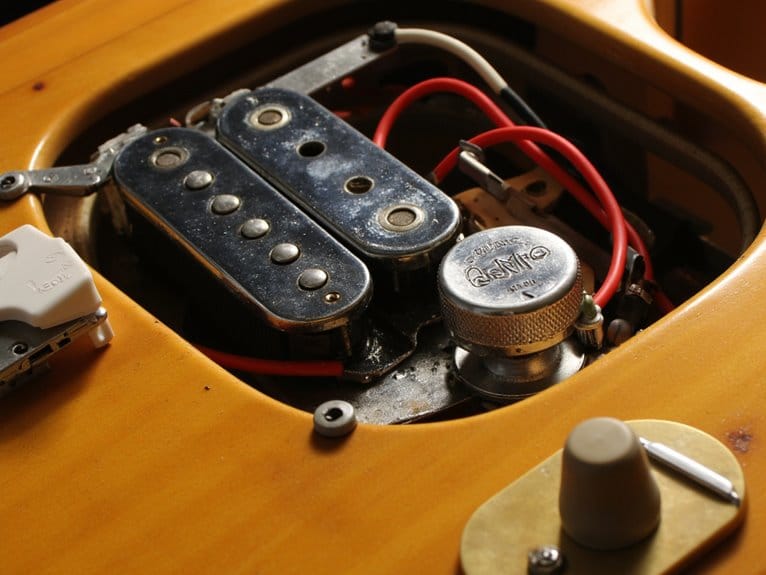Lavalier Microphones: Complete Guide and Setup
Lavalier microphones are tiny, clip-on devices that’ll give you hands-free recording with professional-quality audio capture through condenser technology and diaphragm capsules. You’ll choose between omnidirectional patterns for controlled environments or cardioid for noisy locations, then decide on wired connections for stability or wireless systems for mobility freedom. Position them over your sternum, upside down to reduce plosives, while maintaining input levels between -12dB and -6dB for ideal dynamic range. This guide covers everything you need to master these versatile recording tools.
We are supported by our audience. When you purchase through links on our site, we may earn an affiliate commission, at no extra cost for you. Learn more.
Notable Insights
- Lavalier microphones are tiny, clip-on devices that provide hands-free recording for broadcasting, filmmaking, presentations, and theater applications.
- Choose omnidirectional patterns for quiet, controlled spaces or cardioid patterns for noisy environments with better background rejection.
- Wireless systems offer mobility but require proper channel setup and battery monitoring, while wired connections provide stable transmission.
- Position the microphone over the sternum, mount upside down, and set audio levels between -12 dB and -6 dB.
- Regular cleaning with soft cloths, proper storage in dry cases, and using manufacturer-recommended batteries ensures optimal performance.
What Are Lavalier Microphones and Their Primary Uses
Precision in audio capture often determines the difference between amateur and professional content, and lavalier microphones—those tiny, clip-on devices you’ve probably seen attached to news anchors’ lapels—represent one of the most versatile solutions for hands-free recording.
These compact microphones convert sound waves into electrical signals through a small diaphragm capsule, typically featuring omnidirectional or cardioid pickup patterns that prioritize your voice while reducing background interference. Modern wireless transmission systems have eliminated the constraints of cables, providing unprecedented freedom of movement for performers and speakers.
Their usage scenarios span broadcasting, filmmaking, presentations, podcasting, and theatrical performances where traditional microphones would prove impractical or visually distracting. Lavalier microphones are specifically designed for dialogue capture, making them essential tools for clear speech recording across various media applications.
What makes lavs particularly valuable is their ability to deliver consistent audio clarity regardless of your movement, whether you’re conducting interviews in noisy environments, presenting to corporate audiences, or creating content that demands professional-quality sound without the bulk. Professional systems can achieve impressive transmission ranges of up to 1000 feet while maintaining crystal-clear audio quality for large venues and outdoor productions.
Advanced models now incorporate AI-powered noise cancellation features that automatically filter out unwanted background sounds, ensuring crystal-clear recordings even in challenging acoustic environments.
Types and Polar Pattern Options Available
When you’re selecting a lavalier microphone, you’ll encounter two primary polar pattern choices that fundamentally impact how your mic captures sound: omnidirectional patterns, which pick up audio equally from all directions around the capsule, and cardioid patterns, which focus primarily on sound from the front while rejecting noise from the sides and rear.
I’ve found that understanding these pickup patterns becomes essential since they determine whether you’ll capture natural ambient room tone or achieve isolated vocal clarity, depending on your specific recording environment and creative goals. Cardioid mics provide effective background noise reduction compared to their omnidirectional counterparts, making them particularly valuable in environments with competing audio sources.
Omnidirectional lavaliers excel at group interviews where multiple speakers need to be captured naturally without constant repositioning. Many professional-grade lavalier systems now offer swappable capsule designs, allowing you to interchange different polar pattern capsules on the same transmitter body. This provides remarkable flexibility for adapting to various shooting conditions without purchasing entirely separate microphone systems.
Omnidirectional Vs Cardioid
Understanding polar patterns represents one of the most important decisions you’ll face when selecting a lavalier microphone, as these directional characteristics fundamentally determine how your mic captures sound from different angles and distances. Your choice between omnidirectional and cardioid patterns directly affects audio directionality and performance across various sound environments, making this decision vital for achieving professional results.
| Feature | Omnidirectional | Cardioid |
|---|---|---|
| Sound Pickup | 360-degree capture | Front-focused, rear rejection |
| Environment Suitability | Controlled, quiet spaces | Noisy, outdoor locations |
| Positioning Difficulty | Easy, uniform pickup | Requires precise aiming |
| Frequency Response | Natural, consistent | May shift off-axis |
| Background Noise | Picks up ambient sounds | Better isolation capabilities |
Omnidirectional mics excel when you need natural sound reproduction and accommodate speaker movement, while cardioid patterns provide superior noise rejection in challenging recording environments. The majority of lavalier microphones feature omnidirectional pickup patterns because they provide more consistent audio quality across different speaker positions and head movements. Some advanced lavalier systems offer multi-pattern mics that allow you to switch between different polar patterns for maximum versatility without requiring multiple microphones.
Swappable Capsule Systems
After you’ve determined which polar pattern best suits your recording needs, you might discover that investing in a swappable capsule system offers the ultimate flexibility, allowing you to switch between omnidirectional and cardioid patterns—plus additional specialized options—using the same microphone body.
This capsule versatility transforms a single lavalier into multiple specialized tools through threaded attachment mechanisms that connect via miniature XLR connectors.
Your sound customization options include:
- Cardioid capsules for focused speech with background noise rejection
- Omnidirectional capsules for natural ambiance and interviews
- Super cardioid options for even tighter pickup patterns
- Hyper cardioid capsules for maximum directional control
These modular systems prove cost-effective since purchasing additional capsules costs less than buying separate microphones, while their durable brass construction guarantees longevity across broadcast, theatrical, and acoustic instrument applications. Professional modular capsule systems feature 5mm broadcast-quality components that deliver exceptional clarity for vocals captured at distances of 4″-8″ and instruments recorded from 1″-2″.
Alternative fixed-capsule solutions include dual lavalier setups with 23-foot cables that provide extended positioning flexibility for multi-subject recording scenarios.
Essential Features and Technical Specifications
When you’re selecting a lavalier microphone, you’ll encounter condenser technology in most professional models, which delivers superior sensitivity and frequency response compared to dynamic alternatives, though this enhanced performance comes with specific power requirements that can’t be ignored.
Most lavalier condensers need phantom power ranging from 11V to 52V to operate their internal electronics, and while this might seem like a technical hurdle, I’ve found that understanding these power specs upfront prevents frustrating compatibility issues down the road.
Whether you choose a wired system that draws phantom power from your mixer or recorder, or opt for a wireless setup with battery-powered transmitters, knowing these electrical requirements guarantees your microphone will actually work when you need it most. Wireless systems provide enhanced mobility through their transmitter-receiver configuration, making them particularly valuable for speakers who need freedom of movement during presentations or performances. For optimal audio capture, position the microphone 6-8 inches below the speaker’s mouth to achieve the best sound quality while minimizing fabric noise and other unwanted interference.
Condenser Technology Benefits
Since I’ve spent considerable time testing various lavalier microphones in both studio and field environments, I can confidently say that condenser technology stands as the gold standard for these compact recording devices, offering a combination of sensitivity, clarity, and versatility that’s difficult to match with other microphone types.
The audio clarity these condensers deliver consistently impresses me, especially when paired with their portable design that doesn’t sacrifice performance for size.
Here’s what makes condenser lavaliers particularly effective:
- Superior sensitivity captures vocals from greater distances without requiring proximity adjustments.
- Wide frequency response (20 Hz to 20 kHz) guarantees thorough sound reproduction.
- Minimal handling noise reduces unwanted audio artifacts during movement.
- Professional-grade detail maintains broadcast quality in compact form factors.
You’ll appreciate how these benefits translate into reliable, hands-free recording across various applications.
Proper Placement and Positioning Techniques
After you’ve invested in the right lavalier microphone for your budget and needs, understanding proper placement becomes the difference between professional-sounding audio and disappointing results that no amount of post-production can fix.
Position your lavalier over the sternum, roughly the distance from thumb to pinky when your hand’s outstretched from your mouth, which delivers ideal audio capture with natural tonal balance.
Mount the microphone upside down within its clip to reduce plosives and wind noise, while ensuring the cable doesn’t rub against fabric to minimize rustling sounds.
Consider mic visibility based on your recording scenario—lapel placement works for interviews, while hidden configurations under thin clothing layers maintain professional aesthetics without compromising sound quality through excessive fabric muffling.
Wired Vs Wireless Connection Setup
When choosing between wired and wireless lavalier microphones, you’re fundamentally deciding between reliability and freedom, each option carrying distinct trade-offs that’ll shape your recording experience.
Wired advantages include consistent audio quality, plug-and-play simplicity, and cost-effectiveness, while wireless limitations encompass potential interference, battery dependency, and higher complexity.
Here’s what I’ve learned about each setup:
- Connection reliability – Wired mics maintain stable transmission through physical cables, whereas wireless systems face 70% setup failure rates due to pairing issues.
- Audio fidelity – Wired delivers uncompressed, full dynamic range sound compared to wireless compression.
- Movement freedom – Wireless enables unrestricted mobility but wired restricts range to cable length.
- Cost factors – Wired systems offer lower upfront costs and no ongoing battery expenses.
For optimal wireless performance, look for microphones with 48kHz/24-bit audio quality and signal-to-noise ratios exceeding 80dB to minimize the quality gap between wired and wireless systems.
Your choice depends on project priorities: wired for maximum reliability, wireless for mobility.
Frequently Asked Questions
Are Lavalier Mics Compatible With Smartphones and Action Cameras?
You’ll find smartphone compatibility straightforward with TRRS connectors, though newer phones need Lightning or USB-C adapters.
Action camera integration requires specific adapters since GoPros use proprietary connections rather than standard 3.5mm jacks.
I’ve used wireless systems successfully with both devices, bypassing connection headaches entirely.
Check your camera’s manual for phantom power requirements, and consider dedicated smartphone mics like the Shure MVL for seamless plug-and-play functionality.
How Long Do Batteries Typically Last in Wireless Lavalier Systems?
You’ll typically get 6-15 hours from wireless lavalier systems, though different battery types and power management settings dramatically affect runtime.
I’ve found that transmitters with 300-350mAh capacities usually deliver around 6-8 hours solo, but charging cases can triple that to 15+ hours total.
Your usage patterns, signal strength requirements, and environmental conditions will influence actual performance, so expect variability.
On a final note
You’ve now got everything you need to make informed decisions about lavalier microphones, from understanding polar patterns and technical specs to mastering placement techniques and troubleshooting common problems. Whether you’re choosing between wired or wireless systems, managing audio levels, or maintaining your equipment for long-term performance, these fundamentals will serve you well in any recording situation you’ll encounter.


